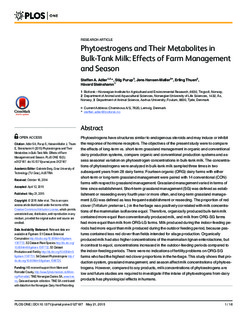| dc.description.abstract | Phytoestrogens have structures similar to endogenous steroids and may induce or inhibit the response of hormone receptors. The objectives of the present study were to compare the effects of long-term vs. short-term grassland management in organic and conventional dairy production systems, compare organic and conventional production systems and assess seasonal variation on phytoestrogen concentrations in bulk-tank milk. The concentrations of phytoestrogens were analyzed in bulk-tank milk sampled three times in two subsequent years from 28 dairy farms: Fourteen organic (ORG) dairy farms with either short-term or long-term grassland management were paired with 14 conventional (CON)farms with respect to grassland management. Grassland management varied in terms of time since establishment. Short-term grassland management (SG) was defined as establishment or reseeding every fourth year or more often, and long-term grassland management (LG) was defined as less frequent establishment or reseeding. The proportion of red
clover (Trifolium pretense L.) in the herbage was positively correlated with milk concentrations of the mammalian isoflavone equol. Therefore, organically produced bulk-tank milk contained more equol than conventionally produced milk, and milk from ORG-SG farms had more equol than milk from ORG-LG farms. Milk produced during the indoor-feeding periods
had more equol than milk produced during the outdoor feeding period, because pastures contained less red clover than fields intended for silage production. Organically produced milk had also higher concentrations of the mammalian lignan enterolactone, but in contrast to equol, concentrations increased in the outdoor-feeding periods compared to the indoor-feeding periods. There were no indications of ertility problems on ORG-SG farms who had the highest red clover proportions in the herbage. This study shows that Production system, grassland management, and season affect milk concentrations of phytoestrogens. However, compared to soy products, milk concentrations of phytoestrogens are low and future studies are required to investigate if the intake of phytoestrogens from dairy products has physiological effects in humans. | nb_NO |

